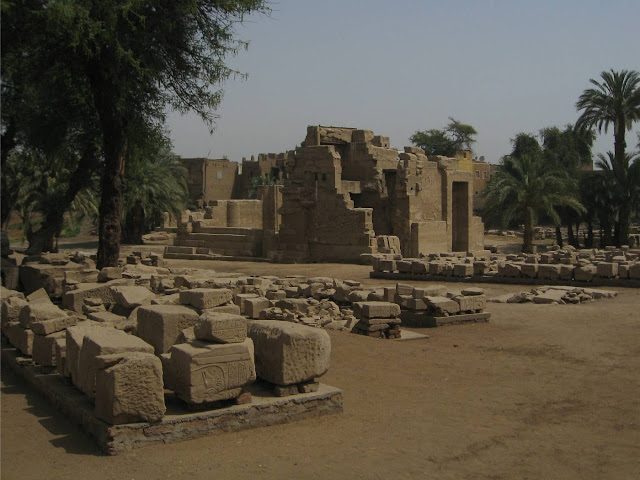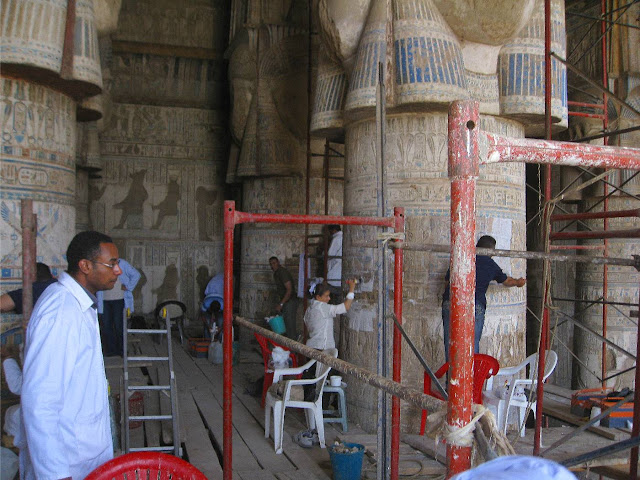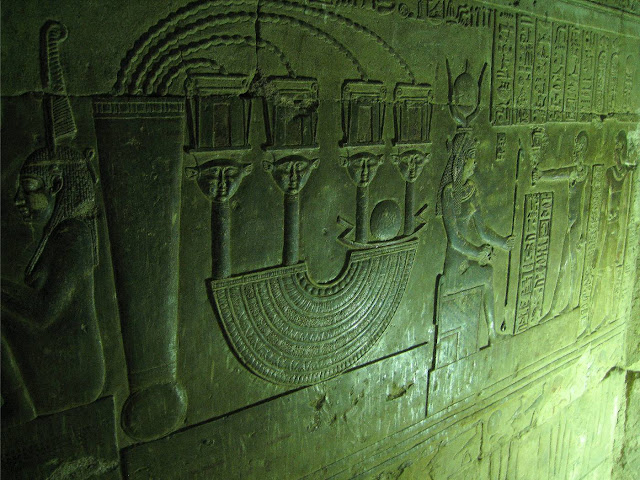One of the first modern visitors to Tod was Jean-Francois Champollion, who would become the decipherer of hieroglyphs and the Father of Egyptology. During his trip in 1828/29, Champollion investigated a 'crypt' that was engulfed by an Egyptian village. Almost a century later another Frenchman, Fernand Bisson de la Roque, cleared the village and began excavations to reveal two halls of the buried temple. The crypt that Champollion investigated and Bisson de la Roque cleared was beneath this chapel dedicated to the consorts of Montu: Tjenenyet and Ra'ttawy. On the walls, the pharaoh is depicted performing the holy rites for the goddesses.
In fact, the chapel was a mammissi, or birth house. At other sites, Dendara in particular, the mammissi was a separate building within the sacred precinct, but they were also built as chapels within a temple. Mammissi commemorated either the birth of the diety or the divine birth of the pharaoh, thus proving his divine right to rule. This special building or chapel appeared in the Ptolemaic period when the pharaohs, of Greek origin, had to prove their birthright. At Tod, the hippopotamus goddess Taweret waddles across the ways. She presided over fertility and childbirth. In her hands she holds what is thought to be a roll of cloth that is tied near one end. This is the hieroglyph sa that symbolized protection. Taweret protected mothers in childbirth and the household in general.
Although the temple is beautiful in its own right, perhaps the most fascinating aspect of a visit today is wandering through the storage area of decorated fragments that have not yet been restored to their proper place in the temple. French archaeologists are still working at the site and have arranged the blocks in groups of like pieces. They have before them a massive jigsaw puzzle and, in this case, each fragment is extraordinary in its own right.
It is in the blockyard that one can see evidence from what may have been the earliest temple at Tod. A slab of pink Aswan granite bears the cartouche of Userkaf, the first pharaoh of Egypt's fifth dynasty. Userkaf ascended the throne in c. 2494 B.C. and ruled for only seven years. Yet within that short space of time he constructed his pyramid at Sakara, a solar temple at Abusir and, perhaps, the temple of Montu at Tod.
The massive granite block was excavated at the site but archaeologists have not found any other evidence for an Userkaf temple. The first temple structure that they have direct evidence for was built by Mentuhotep II in 2050 B.C., some four centuries after Userkaf. It is possible that the block may have been moved from another site and reused at Tod. Unfortunately, no mention of Tod (ancient Djerty) or the god Montu has been preserved on the fragment. Such mention would have been proof positive that Userkaf built a temple here. So the question of the existence of an Userkaf temple remains for open for discussion.
Egyptian temples can be overwhelming when visitors try to comprehend the multitude of figures that are carved on any one wall. Viewing a fragment allows the beholder to appreciate the exquisiteness of the carving. For example, looking at the lion-headed goddess Sekhmet in her original position as a very small part of a complete temple wall, the viewer might easily overlook her regal whiskers, the tautness of her cheek, and the details of her crown. As a goddess of war and protector of pharaohs, she is a feminine compatriot of Montu. She and Montu also originated as solar deities, hence the sun disk crowning her head.
One corner of the blockyard is dedicated to carved architectural fragments from two churches built at the site. One dates to the 5th century A.D. The other was dedicated to Anba Ibshay, a local saint, and was destroyed in late medieval times.
In this section of the blockyard lies a beautiful lintel carved with the Coptic Cross. The cross is derived from the pharaonic ankh, symbol of life. Since the ankh is composed of a T cross with a circle on top, it was an easy step for early Christians to associate it with the eternal life promised by Christ. On the lintel block, the cross is placed inside a building which probably refers to the very church that the stone decorated.
Beneath a church and the Ptolemaic temple's flooring, in the foundation of the Middle Kingdom temple, French Egyptologist Fernand Bisson de la Roque discovered the Tod Treasure. Although the treasure contained silver, lapis lazuli and some gold bullion, the stone fragments that are lined up around the temple seem just as precious.
WHERE TO FIND ME
View Larger Map
The temple itself does not look as impressive from the satellite as it does with feet firmly placed on the earth. The small building in the upper left of the satellite image is Montu's barque shrine, originally built by Tuthmosis III but also bearing decoration from succeeding pharaohs. The square space to the right of the temple are the Roman period walls of the temple's sacred lake.
| GETTING THERE | USEFUL INFO SOURCES |
|---|---|
| Be sure to purchase an entry ticket at Luxor Temple before setting out for Tod. Tickets are not sold at the temple. Ticket price for a foreign adult is 25LE. Head South for 5.6 km beyond the Luxor Bridge. There is a checkpoint at the turn for Tod village. Turn left (East) at the checkpoint and follow the road through the village and past the monastery. At the Y-intersection with a yellow mosque building in the center, turn right (West) and drive for another .3 km to the temple's entrance. | Egyptian Monuments blog by Su Bayfield, Tod |
| Tour Egypt website, The Temple of Montu at Tod in Egypt by Mark Andrews | |
| Louvre Museum Collection 11th Dynasty Relief from the Temple of Monthu at Tod | |
| Louvre Museum Collection The Tod Treasure |






















































